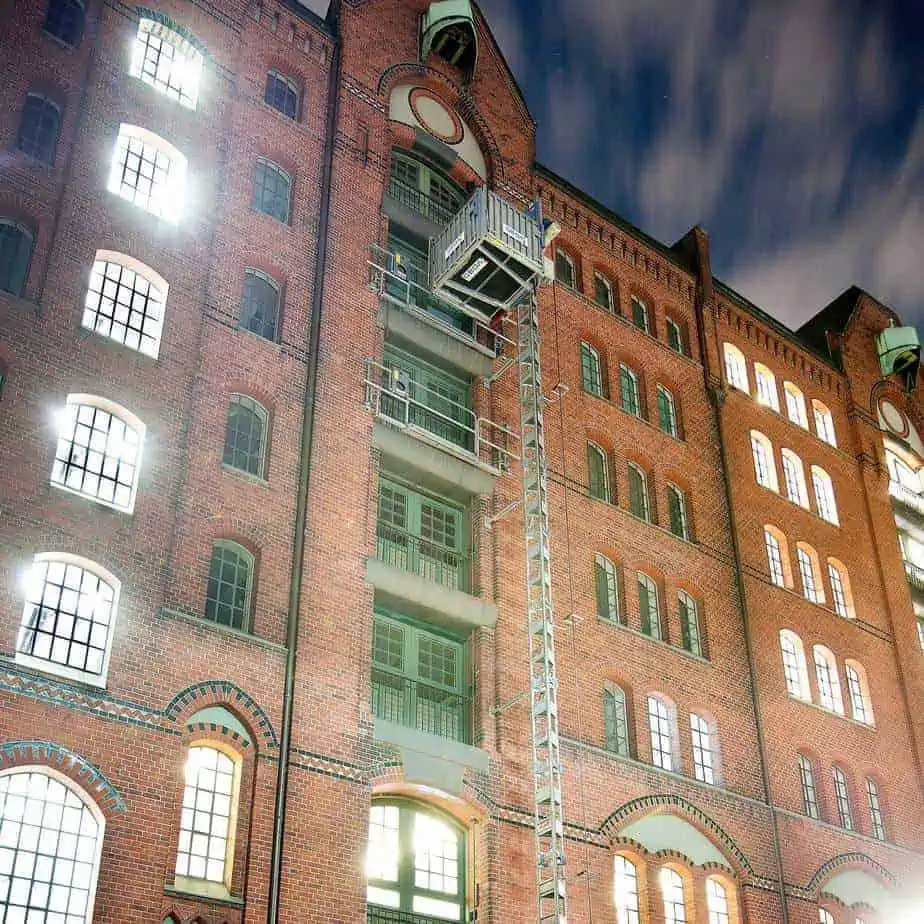Builder hoists, also known as construction hoists or material hoists, are widely used in the construction industry to transport materials and equipment vertically to different levels of a building site. They are an essential part of any construction project, as they help to reduce manual labor, increase efficiency, and ensure safety on the site. This machine handles heavy loads and is common in constructing high-rise buildings, bridges, and other tall structures.
This blog post will discuss the various types of builder hoists, their features, advantages, disadvantages, and the safety measures you must take while operating them.

Types of Builder Hoists
There are primarily two types of builder hoists:
Rack and Pinion Builder Hoists
Rack and pinion hoists use a system of racks and pinions to lift materials and equipment. The rack is a toothed bar that runs vertically along the hoist’s mast, while the pinion is a gear wheel that meshes with the rack to carry and lower the load.
People commonly use these hoists for heavy-duty applications, such as transporting materials and equipment to tall buildings. They are available in various sizes, and you can operate them electrically or manually.
Cable Hoists
Cable hoists use a wire rope or cable to lift and lower materials and equipment. They are ideal for lighter lifting loads and can be operated electrically, hydraulically, or manually.
These hoists commonly apply to medium to heavy-duty applications, such as lifting construction materials to mid-rise buildings. They are also available in many sizes, and their lifting capacity ranges from 300 to 2000 kg.
Features of Builder Hoists
Builder hoists have various features that make them suitable for different construction projects. Some of the essential elements include:
- Lifting Capacity: Builder hoists have varying lifting capacities, depending on their size and type. Rack and pinion hoists typically have a higher lifting capacity than cable hoists and can lift loads of up to 4000 kg. Cable hoists, on the other hand, have a lifting ability that ranges from 300 to 2000 kg.
- Lifting Height: Builder hoists can reach different heights, depending on their size and type. Rack and pinion hoists can reach higher altitudes than cable hoists, with some models reaching up to 500 meters. Cable hoists, on the other hand, have a maximum lifting height of 200 meters.
- Speed: Builder hoists can lift and lower loads at different speeds, depending on their type and application. Rack and pinion hoists are generally faster than cable hoists and can lift loads to 60 meters per minute. Cable hoists, on the other hand, can lift loads at speeds of up to 30 meters per minute.
- Safety Features: Builder hoists come with various safety features to ensure the safety of the operators and the workers on the construction site. Some essential safety features include overload protection, emergency stop buttons, and limit switches.
Advantages of Builder Hoists
Increased Efficiency
Builder hoists can significantly increase the efficiency of a construction project by reducing the time and effort required to transport materials and equipment vertically. They can transport more materials and equipment simultaneously, saving time and labor costs.
Improved Safety
Builder hoists provide a safer alternative to manual lifting and transporting materials and equipment. They also come with various safety features, such as emergency stop buttons, overload protection, and limit switches, further improving their safety.
Reduced Labor Costs
Builder hoists can significantly reduce labor costs by reducing the number of workers required to transport materials and equipment vertically. It saves a lot of time and reduces the risk of accidents on the construction site, saving money on worker’s compensation claims and insurance premiums.
Versatility
Builder hoists are versatile and are usable for many construction projects, including high-rise buildings, bridges, dams, and other large-scale projects. They can transport various materials and equipment, including concrete, steel, bricks, and other heavy materials.
Disadvantages of Builder Hoists
High Initial Cost
Builder hoists can be costly to purchase or rent, especially for small construction projects. The cost of a builder hoist depends on its lifting capacity, lifting height, and speed, as well as its type and features.
Maintenance and Repair Costs
Builder hoists require regular maintenance and repairs to operate efficiently and safely. The cost of maintenance and repairs can be high, primarily if the hoist needs to be maintained correctly.
Limited Mobility
Builder hoists are stationary and can only transport materials and equipment vertically. They cannot move horizontally, which can limit their use on some construction sites.
Safety Measures for Operating Builder Hoists
Operating builder hoists can be dangerous, and one must take proper safety measures to prevent accidents and injuries. Some of the essential safety measures include:
Proper Training
Operators of builder hoists should train on the proper operation of the hoist, including its features, limitations, and safety procedures. They should also prepare to respond to emergencies like power outages or equipment failures.
Regular Maintenance
The maintenance of builder hoists should be regular to operate efficiently and safely. Maintenance should include checking the hoist’s cables, brakes, and other critical components.
Load Limitations
Builder hoists should only be used to transport loads within their lifting capacity. Overloading the hoist can cause equipment failure or accidents, resulting in injuries or death.
Safety Equipment
Workers operating or working near the builder hoist should wear appropriate safety equipment, including hard hats, safety glasses, and high-visibility clothing. They should also use safety harnesses when working at heights.
Conclusion
Builder hoists are an essential part of any construction project, as they help to reduce manual labor, increase efficiency, and ensure safety on the site. They come in different types, sizes, and lifting capacities, making them suitable for other construction projects. However, operating builder hoists can be dangerous, and you should take proper safety measures to prevent accidents and injuries. By following the recommended safety procedures and guidelines, construction workers can operate builder hoists safely and efficiently, controlling the risk of accidents and injuries on the construction site.




